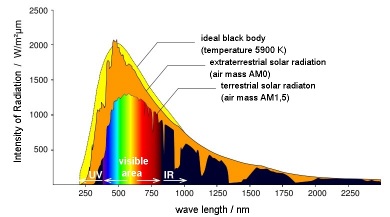|
|
 |
|
|
|
 |
 |
|
|
 |
The Sun as energy source
|
Key words of this unit:
Sun as energy source, solar constant, inclination of the Earth's axis, seasons, angle of solar radiation, energy distribution |
|
 |
 |
|
Fig 1: Beach in Cannes. Photo: Thomas Steiner
© GNU Licence Wikipedia
|
|
 |
Nearly all energy which is driving life, weather, climate and natural processes at the Earth's surface comes from the Sun. Life on Earth would not be possible without the Sun. And this dosn't just mean beach life!
|
|
Only a tiny fraction of the energy which has an influence on our environment originates from the liquid inner part of the Earth. This energy, which is still present from the formation of our planet is used, for example, in geothermal heat pumps. During volcanic eruptions the energy shows up in a natural way. The climate system and human induced climate change do not have any influence on processes inside the Earth, neither on volcano eruptions nor on earthquakes. If people die from volcano eruptions or earthquakes, climate change cannot be made responsible for this.
|
|
Radiation from the Sun
The Sun transfers its energy by electromagnetic waves. We call them light. But often we think light is only the part of the radiation we can see with out eyes.
|
But the Sun also transfers energy which is more energetic than the visible light. We call this radiation UV light. Too much UV light damages the cells of plants, humans and animals. Fortunately, the ozone layer at an altitude of 15-40 km absorbs a good fraction of this highly energetic and dangerous radiation.
|
 |
 |
 |
|
Fig 2: This figure shows the original spectrum of the solar radiation idealised (yellow), at the upper end of the atmosphere (orange) and at the Earth's surface after being modified by the atmosphere (multicolor, black). The black areas represent light, which is not visible for our eyes. The energy of the radiation decreases from left to right.
© Wikimedia Creative Commons Licence
|
|
|
The Sun also emits heat radiation with a lower energy than visible light. We call it infrared light or infrared radiation. We feel it as heat on our skin, similar to the invisible heat radiation of a hot plate.
The radiation of the Sun rushes with the unbelievable speed of 300,000 km/s (speed of light) through space and covers a distance of 150 million kilometres from the Sun to the Earth in about 8 minutes.
|
|
Amount of transferred energy
Amounts of energy are measured in Joule. The Sun transfers in each second and amount of 1367 J on each square metre of the Earth's diameter. This corresponds to a power of 1367 Watt [1 Watt = 1 Joule per second]. We call this value the "solar constant".
But for two reasons this energy does not continuously reach each square metre of the Earth's surface. The reasons are: 1) the geometry of the Earth 2) the influence of the atmosphere.
|
|
For a more detailed explanation see also example 3 on the following page:
http://www.atmosphere.mpg.de/enid/5iz.html
1) Geometry of the Earth: The Earth is not a disc facing the Sun but a sphere. Therefore, the sun does not irradiate the Earth vertically but in most regions at a certain angle. On the night side of the Earth, there is no irradiation at all. The cross section of a sphere, which is vertically hit by the sun, is only one quarter of its surface. Therefore only ¼ x 1367 Watt = 342 Watt per square metre reaches the upper atmosphere.
|
|
|
 |
Fig 5: The same energy which is transferred by parallel sun rays to the Earth hits an area the size of which depends on the angle of the incoming wave. Also the length of the path through the atmosphere is different and the rays become weaker the longer the path.
© GNU Licence Wikipedia, modified |
|
2) The sunlight cannot pass the atmosphere and reach the Earth' surface unchanged. Clouds, ice and snow-covered areas reflect it. Gases and dust in the air take up the energy and reemit it in all directions, also back to the space. In the end, about 168 Watt from an average of 342 Watt are absorbed by the Earth.
But, in comparison, only about 0.06 W/m2 come as heat radiation from inside the Earth. This is more than 2000 times less than the power of the Sun.
|
Distribution of the energy
We know that the climate close to the equator is warmer than at the North Pole or South Pole. We also know that summer is warmer than winter. The energy of the Sun does not spread evenly in all regions of the world. It also changes with the season since the Earth's axis is tilted with an angle of about 23.3°. We can visualise these differences in an "experiment" with the help of a globe.
Further visualisation can be found in the linklist under the topic "inclination of the Earth and seasons".
|
 |
 |
 |
|
Animation: Elmar Uherek
|
|
|
 |
|







